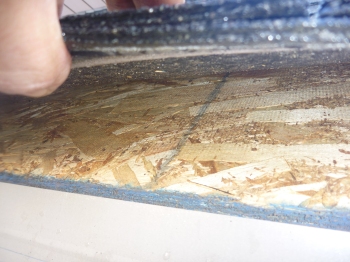It is pretty rare to find a home around the Salem Oregon area that is built with the basement in the last 20 years. The reason for this is basements are low, cut into the ground, and in this part of the country the water tables rise in the wintertime and it takes extra work to keep these basements dry. There are a few newer homes being built with basements and the techniques and materials they use for waterproofing these basements have come a long ways. For the most part, the added expense of waterproofing has been traded for more straightforward and larger margins for error with the crawlspace design. If water enters a crawlspace it is not imidiately damaging however it is not good to have a seasonal lake in your crawlspace either!
So let’s assume you own a home or are interested in buying a home that has a basement or crawlspace. Let’s look at some areas to keep your eye on and ideas for fixing the issue of water in basements and crawlspaces.

The picture above shows typical areas that home inspectors look for when inspecting basements. Water stains cannot tell you how often the leakage occurs but it does indicate an issue and something that may need further investigation and repair.
In Salem, Oreogn, most of the water penetration issues in basements or crawlspaces will be related to ground water. The term “ground water,” refers to the water table. The water table is the point in the ground where saturation reaches full capacity. Picture the water table like a sponge that is stood up on end, and water is added. The water will flow through the sponge and pool up at the bottom until gravity overcomes surface tension. The line of saturation at the bottom is kind of like the water table. As we recieve rain the ground soaks it up. The amount of rain we get determines how high the table will rise. The water table is continually rising and falling based on the percipitation.
Now dig a hole in that sponge and place footings and foundation walls for a basement or crawlspace. Quickly you realize that basements and crawlspaces are the first places to get wet.

What now? Now that we know where that water is comming from we can look for solutions.
Sump Pumps-
By the time the buyer’s home inspection is conducted time tables are short and repairs are needed quickly. This can be troubling because to properly fix a basement/crawlspace water issue you should take some time to properly diagnose the issue. Sump pumps have become the do-it-all band-aid and often the water issue should have been corrected in a another area. Sump pumps should be a last resort, and unfortunantly in the real estate world they are usually the first idea, due to the time constraints.

In general the water in the crawlspace or basement needs to be rerouted at the source. Determining where the water is coming from takes time. I met a wonderful Salem agent years ago when she was envolved with a buyer and a wet crawlspace. I was hired by the seller to help determine why there was water in the crawlspace. The buyer’s inspector stated that there was water in the crawlspace and repairs were needed. The sellers hired a waterproofing contractor and the contractor told them they needed a sump pump and trenching (surprise, surprise! contractor’s feed their familys by installing sump pumps and trenching!). I came in and started looking at where and why the water was entering the crawlspace and, over the course of two weeks of rainy weather and diagnostics, the seller ended up disconnecting the downspout near the front entry slab, routing it away from the home and *poof* the crawlspace dried up! Without digging up the entire perimeter of the home it was speculated that the underground downspout piping was crushed/disconnected/plugged near the front entry slab and dumping all of the water collected by the roof and gutters right against the foundation and crawlspace!
Would a sump pump have dried up the crawlspace too? Yes, however sump pumps are perennial maintenance items and must be checked on to verify that they are working properly. I don’t know about you, but I prefer to not enter my crawlspace if I don’t have to. Why use a pump that needs constant attention in a place that I don’t want to go?
That situation was unusual because we actually had time to find and properly diagnos the problem. Unless you get a “pre-sale” or “seller’s” inspection, you usually do not have that kind of time to ferret out the real cause of the water.
That situation was not unusual in the fact of water in basements and crawlspaces ususally manifests from gutters and downspouts. These are the first places to investigate and repair if water issues are noted. If your home was built in the last 20 years your downspouts will pour into underground piping. It is critically important that these pipes are functional and if these pipes are plugged or crushed it is time to do some shovel work. If you do have to re-route your downspouts a good rule of thumb is that the downspouts need to dump at least 10 feet away from your home! Those silly little splash blocks, although they may make an FHA appraiser happy, are not a good solution for keeping your basement or crawlspace dry.

What if you have a basement, you have made sure all of the storm water dumps 10 feet away and downhill of your home and you STILL have moisture issues periodically in your home, whats next?
 The next post I will delve into some other options for “de-watering” or drying out your home.
The next post I will delve into some other options for “de-watering” or drying out your home.














